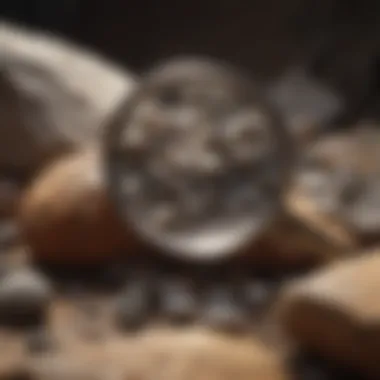Identifying Your Rock Collection: A Complete Guide


Intro
Rock collecting is more than just a hobby; it's an adventure into Earth's past. For collectors, every rock tells a story, echoing the processes that shaped our planet. Many enthusiasts find themselves driven by a desire to identify the rocks and fossils they collect, seeking to unlock the secrets hidden within these geological treasures. However, the identification process can be daunting, especially for those new to the craft.
Understanding what you’ve got in your collection is crucial not just for your own knowledge but also for engaging meaningfully with the broader geological community. This guide is designed to help collectors, from novice rockhound to seasoned enthusiast, identify your collection with confidence. Let’s delve into the fascinating world of rock and fossil identification, exploring all the tools and tips that can enhance your understanding of the Earth’s materials.
Rock and Fossil Identification
Types of Rocks and Fossils
Before you can dive deep into rock identification, it’s essential to know the types you might come across. Rocks are categorized into three main types: igneous, sedimentary, and metamorphic.
- Igneous Rocks: Formed from molten materials, these rocks can often be identified by their crystalline appearance. Think granite and basalt.
- Sedimentary Rocks: Created from particle accumulation, sedimentary rocks may display layered textures. Consider limestone and sandstone in this mix.
- Metamorphic Rocks: These rocks have transformed under heat and pressure, bringing new textures and patterns. Marble and schist are common examples.
Fossils, on the other hand, include remnants of ancient life, which can range from small shell fragments to large dinosaur bones. Identifying fossils often involves recognizing the characteristic shapes and patterns that signify specific organisms.
Characteristics to Look For
When identifying your specimens, pay close attention to the following:
- Color: Variations can hint at mineral composition.
- Texture: Smooth, rough, banded, or speckled textures can help narrow down your classification.
- Hardness: Use the Mohs hardness scale to scratch your specimen and judge its hardness against standardized minerals.
Identifying characteristics will often serve as the foundation for any correct identification you make.
Tools for Identification
To aid in your identification journey, equip yourself with the right tools:
- Hand Lens: Zoom in on mineral structures and textures.
- Field Guide: A good rock and fossil field guide will have pictures and descriptions that are invaluable for identifying specimens.
- Scratch Kit: This kit helps in assessing hardness levels.
- Online Communities: Engaging with platforms like Reddit or Facebook can connect you with fellow collectors who can provide insights or even help with identification.
“The more you know about your collection, the richer the experience becomes.”
Collecting Tips and Techniques
Best Practices for Collecting
When out in the field, keep these best practices in mind:
- Research Locations: Knowing the type of rocks found in particular areas can guide your hunt.
- Legal Considerations: Always ensure you have permission to collect rocks in a specific area to avoid legal troubles.
Locating Prime Collecting Sites
Prime sites for rock hounding often rely on geological history. Areas that have undergone significant erosion or that are near mountains with exposed bedrock can show great potential. Local geological surveys often detail places worth checking out.
How to Safely Extract Specimens
Safety is paramount. Always:
- Use appropriate tools like a rock hammer and chisel.
- Wear safety goggles to protect your eyes from flying debris.
- Respect nature and avoid over-collecting, ensuring that you don’t strip an area bare.
Preservation and Display
Techniques for Preserving Rocks and Fossils
Proper preservation ensures that your collection remains in top condition. Always wash specimens gently to remove dirt, and consider using wax or oils on specific types to maintain luster.
Proper Storage Methods
Store your cherished finds in clear, breathable containers to avoid moisture build-up. Avoid damp, humid environments that can cause deterioration.
Creative Display Ideas
Why not showcase your collection with style? Build a custom display case or use shadow boxes. Some collectors even create themed displays centered around specific types or geological periods.
Geological Insights
Geological Formations and Processes
To fully appreciate your specimens, understanding the geological context is vital. Studying how rocks form—in processes such as cooling magma or sediment deposition—can enhance your identification skills.
Historical Significance of Rocks and Fossils
Each rock or fossil has a story to tell. Research their history within the broader context of Earth’s evolution. For example, the fossil record can provide clear insights into what life was like millions of years ago.
Notable Discoveries in the Field


The geological community is brimming with discoveries that have reshaped our understanding of natural history. Stay abreast of recent finds or historical milestones to deepen your engagement with rock and fossil collecting.
Through careful observation and comprehensive study, you will not only learn to identify rocks and fossils more effectively, but you'll also develop a profound appreciation for the stories they tell. Enjoy your journey into the fascinating world of geology!
Understanding the Importance of Identification
Identification of rocks is more than just a hobby or a way to pass the time; it’s a gateway into the vast and varied world of geology. For rock collectors, having a solid grasp of identification techniques not only enhances the value of their collections but also deepens their connection to the natural world. Understanding what a rock is can unfold numerous stories about its origin, formation, and the earth’s history.
The Role of Identification in Collecting
When one engages in rock collecting, it’s akin to piecing together a grand puzzle. Each specimen has its own attributes—color, texture, weight—that not only define it but also contextualize its experience within the geological timeline. By identifying rocks, collectors enable themselves to establish their own objectives in the hobby, whether it’s merely to enjoy the aesthetic diversity or to accumulate valuable specimens.
Moreover, precise identification helps in fostering a sense of community among collectors. Imagine discussing a rare quartzite with someone who shares your fascination; the conversation ignites when facts and stories bounce back and forth. It encourages exchanges of tips, local finds, and even potential trades. The thrill of identifying rocks can satiate a deep-seated curiosity not just in oneself but also within a community that thrives on shared knowledge.
Contributions to Scientific Knowledge
The act of identifying rocks is not just an individual journey; it contributes significantly to the broader landscape of scientific knowledge. Each identified specimen can provide clues about the geological environment it came from, offering insights into processes such as erosion, sedimentation, and volcanic activity. When collectors accurately identify and document their finds, they unwittingly partake in a larger conversation about our planet's history.
"The more we understand rocks, the more we understand our earth’s story. Every stone has a tale, it’s up to us to listen."
For instance, a collector who identifies and reports a rare mineral find helps geologists refine their maps of mineral deposits, ultimately aiding in research or ecological conservation efforts. This bidirectional exchange between hobbyists and scientists highlights the mutual benefits that arise from fostering identification skills.
In summary, grasping the importance of rock identification sets the foundation not only for an enriching personal journey through geology but also for invaluable contributions towards a collective understanding of Earth's processes. Collectors stand as amateur ambassadors of scientific exploration, illuminated by their efforts to identify the very building blocks of our planet.
Basic Techniques for Rock Identification
Identifying a rock collection goes far beyond just seeing colorful pieces in a box; it’s about understanding each specimen's story. Knowing the basic techniques for rock identification is crucial for several reasons. First, it enhances a collector's enjoyment and appreciation of each specimen. When you can look at a rock and see not just its surface but comprehend its origin and characteristics, that’s a treasure trove of knowledge. Additionally, accurate identification helps ensure proper care and conservation of the specimens.
Visual Identification
Visual identification lays the groundwork for recognizing rocks and minerals. It's the first step, often taken by both novice and seasoned collectors. Observing the color, shape, and overall appearance allows collectors to make a preliminary assessment before delving deeper.
This method offers an immediate connection; after all, a rock’s outward characteristics are often what initially attract a collector. Visual cues can help us narrow down the possibilities significantly, pointing towards specific rock types or categories. However, while it's an intuitive approach, it’s important to remember how sometimes appearances can be deceptive. Relying solely on visual identification may lead to assumptions that might not hold up when scrutinized under scientific conditions.
Physical Properties Assessment
Understanding physical properties is essential in rock identification. It involves looking closely at a rock's color, texture, and fracture patterns. Each of these aspects can reveal a wealth of information about the rock’s history and classification.
Color Observation
Color observation, while simple, plays a significant role in identifying rock types. It's often the first thing one notices. For instance, the bright hues of a mineral can serve as a quick indicator for certain types like malachite or turquoise. Color can help in distinguishing between similar rocks or minerals.
However, attributing too much importance to color can be misleading. Environmental factors, lighting, and the presence of weathering can alter a rock’s original color. The vibrancy of a freshly discovered specimen might not match what you see on the shelf; thus, it requires caution.
Texture Examination
Texture examination provides a wealth of insight into how a rock was formed. It includes assessing the rock’s grain size, pattern, and composition. Rough, gritty textures can indicate erosion processes, while smooth textures may hint at volcanic origin.
Texture is beneficial here because it can signify whether the rock is igneous, sedimentary, or metamorphic, leading to informed conclusions. But sometimes, rocks with strikingly different appearances may share similar textures, posing a challenge during identification.
Fracture Patterns
Fracture patterns reveal essential information about a rock’s internal structure and stress history. When a rock breaks, it does so in predictable patterns. For example, quartz typically exhibits conchoidal fractures, while others might break in more angular forms.
This method gives collectors another tool in their toolkit, making it a favorite among those keen on understanding their finds at a deeper level. However, recognizing these patterns can take time and practice. The uniqueness of different fracture types means that this approach requires patience and careful observation.
Use of Acids and Other Tests
Some rocks and minerals can only be accurately identified through tests using acids and other methods. Acid tests can help determine the presence of carbonates; for instance, a drop of vinegar or dilute hydrochloric acid will effervesce when it contacts calcite.
These chemical tests, while more advanced, can greatly enhance a collector’s understanding. They are particularly vital in confirming suspicions raised by earlier identification techniques and distinguishing between similar specimens. By engaging in these tests, you build a more comprehensive picture of your rock's identity.
Utilizing Technology for Identification
In this digital age, technology has entered the world of rock collecting, completely changing how enthusiasts identify and understand their specimens. Utilizing technology for identification has become not just a convenience but, for many, a necessity. With the click of a button, collectors can access vast reservoirs of information pertaining to minerals, rocks, and fossils from anywhere in the world. This section will discuss the benefits of employing technology in rock identification, focusing on mobile applications and online databases that can significantly aid in refining one’s knowledge.
Mobile Applications for Enthusiasts
When it comes to identifying rocks and minerals, mobile applications can be a game-changer. These handy tools allow collectors to utilize their smartphones as powerful microscopes or identification aids. Apps such as Rock Identifier and Mineral Scanner have gained popularity among collectors of all levels. These applications often incorporate built-in image recognition technology, allowing users to take a picture of a rock and receive instant feedback about what it might be.
The convenience of having an identification tool right in your pocket is transformative for anyone who frequents quarry sites, craft fairs, or even roadside stops with a geological interest. But there are more to these apps than just identification. Some of the standout features include:
- Educational Guides: Many of these apps provide educational resources and guides on various rock types, enabling users to deepen their understanding beyond superficial identification.
- Local Geology: Some applications utilize your location services to provide insights into geological features native to your area, which can enhance field studies.
- Community Sharing: Certain platforms allow users to share their discoveries, gaining insights from fellow collectors, and fostering community engagement.
In a notion that resonates with tech-savvy hobbyists, one might say, "With the right app, you’re carrying a tiny geologist in your pocket."


Online Databases and Resources
Online databases serve as an invaluable asset for people delving into rock and mineral identification. Websites such as Mindat.org and The Mineralogical Society of America have curated extensive datasets filled with essential information. These resources offer not only visual representations of rocks and minerals but also include geochemical properties, crystal structures, and locality of specimens. As a collector, this information can be critical in ensuring the integrity of individual collections.
The benefits of online databases extend into different realms:
- Global Access: Retaining a wealth of data accessible globally means that information is just a search away, regardless of geographical constraints.
- Regular Updates: Online resources are often updated with new research, ensuring collectors always have the most current information.
- Community Contributions: Many databases welcome user submissions, allowing collectors to contribute their own findings and experiences, enriching the collective knowledge base.
Engaging with these online platforms can also act as a springboard into the wider geological community. Joining forums, participating in discussions, or simply browsing through shared experiences can provide insights that one might not find in textbooks or during solitary fieldwork.
Overall, leveraging technology in rock identification does more than just simplify the process; it opens doors to a global community while enhancing learning opportunities about the fascinating world of geology.
"The future belongs to those who understand the importance of nurturing their passion with modern tools."
Through this integration of technology and traditional practices, collectors can enrich their experience, build connections within the community, and ultimately engage more deeply with their geological pursuits.
Engagement with the Geological Community
Engaging with the geological community is vital for collectors, as it provides a wealth of knowledge and resources that can greatly enhance one's understanding of rock and mineral identification. Being part of a community offers both social and educational benefits. Collectors can share insights, exchange techniques, and showcase their finds while learning from others’ experiences. This two-way interaction fosters a sense of belonging and motivates enthusiasts to delve deeper into their passion.
Joining Local Clubs and Societies
Joining local clubs and societies dedicated to geology presents a golden opportunity for collectors. These clubs often organize events like field trips, where enthusiasts can explore local geological formations and practice their identification skills. This real-world experience is invaluable since each region has unique geological characteristics. Joining such groups can also open doors to seminars and workshops led by experienced geologists, providing insights that books often can't offer.
Another significant advantage of connecting with a local club is the chance to build relationships with fellow collectors. A camaraderie develops among members, enabling informal exchanges about best practices, recent discoveries, and techniques that might otherwise be overlooked. Enthusiasts often refer to these connections as a sort of "rock family," where members uplift one another through shared interests and knowledge.
- Field trips allow members to witness varying geological landscapes.
- Workshops introduce new techniques for collection and preservation.
- Networking with experienced geologists provides mentorship opportunities.
Further, many clubs organize participation in geological fairs, giving you a platform to showcase your collection. This recognition can be quite rewarding and can lead to deeper insights into your specimens, allowing you to appreciate their rarity and significance,
Participating in Online Forums
In the digital age, engaging with the geological community extends well beyond local clubs. Online forums and platforms host vibrant discussions and provide a treasure trove of information. Forums such as those found on Reddit or specialized Facebook groups attract members from all over the globe, bringing together a diverse range of experiences and knowledge.
In these virtual spaces, collectors can ask for assistance in identifying specimens when they're in a pinch. Sharing high-quality images of stones or fossils often garners quick insights from seasoned collectors or geologists who frequent these forums. Furthermore, the digital format allows for discussions on global rock formations, which can broaden one’s horizon and appreciation for geology on a larger scale.
- Interaction with experts across the globe.
- Instant feedback on queries about specific specimens.
- Access to a wealth of shared experiences and resources.
Otthe benefit of these online communities is that they are always open. Whether it's day or night, an enthusiast can log on and seek advice, share findings, or simply learn something new surrounding their favorite hobby.
The natural world is a profound teacher, and engaging with others can amplify the lessons of geology, making it essential for anyone serious about their rock collection.
Educational Resources on RelictVibe
When it comes to rock collecting, knowledge is a powerful tool that can equip both new and seasoned collectors. Educational resources on RelictVibe provide a vast pool of information, making it easy for hobbyists to deepen their understanding of geological specimens. The platform combines accessibility with expertise, ensuring that every rock enthusiast has the opportunity to expand their skill set and enhance their collection-related endeavors.
In-Depth Articles on Rock Types
One of the standout features of RelictVibe is its extensive library of articles focused on various rock types. These articles delve into the composition, formation processes, and geological significance of different rocks. Understanding these elements can be crucial for collectors aiming to identify and appreciate the fine details within their collections.
For instance, an article discussing sedimentary rocks often highlights the formation of fossil-rich layers, tying in historical contexts that illuminate a rock's journey through time. This level of detail helps to bridge the gap between mere collection and a genuine appreciation of the specimens.
Resources the readers should seek out include:
- Visual Guides that illustrate distinct characteristics of different rock types.
- Case Studies showcasing specific examples and their importance in geology.
- Practical Tips for identifying various types of rocks on-site during field trips.
Guides on Collection Techniques
Building a collection isn't just about acquiring rocks; it's about understanding how to collect responsibly and intelligently. RelictVibe offers practical guides on collection techniques that cover everything from selecting the right tools to honing your observational skills. These resources are invaluable, particularly for those who may be new to the practice or unsure about the best methods to employ.
- Selecting Tools: An important aspect of rock collecting lies in having the proper gear. Guides on RelictVibe outline the usage of basic tools such as hammers, chisels, and field notebooks, promoting safe practices.
- Observation Methods: Techniques for identifying subtle attributes, such as color variations and textural nuances, are also discussed. This attention to detail can make all the difference when attempting to classify a specimen accurately.
- Ethical Collecting Practices: Such guides emphasize the significance of sustainability and respect for locations. Collecting responsibly not only aids in preserving natural landscapes but also fosters goodwill within local communities.
As rock collectors dive into the resources available through RelictVibe, they will find that the opportunity for learning is practically endless. Whether one seeks a deeper understanding of specific rock types or desires practical advice on effective collecting practices, these educational articles and guidelines position enthusiasts to thrive in their geological pursuits.
"Knowledge is the compass that guides the avid collector through the vast landscape of geology."
Ultimately, exploring educational resources on RelictVibe can serve as a cornerstone for any collection strategy. As collectors enhance their skills and knowledge, they embark on a journey that is as enriching and diverse as the geological specimens they seek.
Advanced Identification Methods
When one truly steps into the world of rock collecting, there’s more than just picking up pretty stones. Advanced identification methods elevate your understanding and appreciation of rock specimens, offering a pathway to discern nuances that the untrained eye might easily overlook. From intricate mineral compositions to distinct structural features, these techniques can significantly enhance both the collector's display and the scientific value of their collection.
"Understanding your collection is like opening a door to a geological library, where each specimen tells its own unique story."
Using Microscope and Polarization Techniques


In the age of technology, the microscope stands as a collector's best friend. This powerful tool allows for a closer look at the mineral constituents of a rock, revealing aspects invisible to the naked eye. With the ability to magnify specimens thousands of times, one can observe crystal structures, grain sizes, and even the presence of specific minerals.
Polarization techniques take this a step further. Under polarized light, not only do you get a clear view of minerals based on their optical properties, but you can also distinguish between similar-looking materials. For instance, quartz and feldspar may appear quite similar without proper examination. A polarized light microscope can help differentiate these minerals effectively, ensuring a more accurate classification.
Benefits of Using a Microscope:
- Increased Detail: Examine features like cleavage planes and twinning.
- High Accuracy: Develops a strong foundation for identifying minerals.
- Educational Value: Enhances understanding of geological processes at a microscopic level.
Field Testing Techniques
Field testing techniques are indispensable for collectors who want to learn more about the environments where their rocks originated. These methods not only add context to your specimens but also enrich the narrative behind each rock.
Many collectors have found value in hands-on tests. For instance, a simple hardness test—scratching the rock against a material of known hardness—can indicate mineral composition. The Mohs scale, ranging from talc to diamond, serves as a useful guide here.
Similarly, performing acid tests can help identify carbonate minerals. A drop of hydrochloric acid on calcium carbonate, for example, will produce effervescence, marking its reactive nature.
In addition to these tests, understanding the geological setting is essential. Factors such as:
- Soil Composition: Attributes captured from the parent rock.
- Surrounding Vegetation: Can give clues about mineral deposits in the area.
- Fossil Presence: Indicates sedimentary environments and past biological activity.
Ethical Considerations in Collecting
Understanding the ethical dimensions of rock collecting is as crucial as mastering the techniques for identification. This consideration influences how collectors interact with the environment, fellow enthusiasts, and even the scientific community. Cultivating responsible habits can ensure that our passion does not come at the cost of ecological damage or illegal practices, fostering a culture of respect and sustainability.
Sustainable Collecting Practices
One of the most important aspects of responsible collecting is sustainability. Sustainable collecting practices are about finding that sweet spot where enjoyment and conservation meet. When gathering specimens, it's essential to keep in mind the long-term health of the ecosystems you are exploring. Here are some key principles to guide sustainable collecting:
- Leave No Trace: When you find a rock that catches your eye, consider whether removing it will disrupt the local environment. Sometimes it's better to photograph it and leave it in place.
- Limit Your Collection: Aim to collect only what you will reasonably use or display. Over-collecting can deplete local supplies of rocks and fossils, disrupting the natural landscape.
- Know Your Locations: Some areas are designated as protected sites. Before heading out, research and understand the regulations for collecting in those specific locations.
By prioritizing sustainability, you not only protect the geological sites for future generations but also enhance your own experience by promoting responsible appreciation of nature.
Legal Regulations on Rock Collecting
Equally important as sustainable practices are the legal regulations on rock collecting. These laws are designed to protect both geological resources and biodiversity. Ignoring them can lead to hefty fines or even criminal charges. Here’s a quick roundup:
- National Parks and Protected Areas: Collecting rocks in these areas is typically prohibited. Always check local rules before visiting, as these regulations are in place to conserve natural heritage.
- State Laws: Different states have varying rules regarding rock collecting. For instance, some may allow small-scale collection for personal use, while others are much stricter.
- Private Land: Always obtain permission if collecting from private property. Trespassing and collecting without consent can lead to serious legal repercussions.
Understanding these regulations not only protects you but also helps foster a culture of ethical collecting. It's vital to stay informed to ensure that your hobby does not inadvertently harm the environments you cherish.
"When collectors operate within the bounds of ethical practices, they contribute positively to the geological community and the environment."
Spotlighting Notable Geological Formations
When talking about rock collecting, understanding notable geological formations can be a game-changer. These formations often tell the story of our planet's history and showcase the stunning variety of rocks available for collectors. Knowing about these sites can enrich not just your collection but also your overall appreciation for the natural world.
Famous Rock Sites Around the World
Several locations around the globe stand out for their unique rock formations. Each of these sites offers a different aesthetic and geological importance, making them must-see destinations for any enthusiast. Here are a few worth exploring:
- Uluru, Australia: Known also as Ayers Rock, this massive sandstone monolith is famous for its vibrant colors that shift with the time of day, making it a breathtaking sight.
- Grand Canyon, USA: Layers of sedimentary rocks expose millions of years of geological history, offering insights into Earth’s past. The diverse rock types present here are invaluable for anyone looking to understand erosion and geological time scales.
- Stonehenge, England: The bluestones used in this prehistoric monument come from the Preseli Hills in Wales, and their origins are a mystery that continues to intrigue both scholars and collectors alike.
Each of these sites has its own unique characteristics that can inspire collectors and provide deeper understanding. Visiting such locations not only allows collectors to observe formations in their natural habitat but to also connect with the surrounding culture and history that often accompany these sites.
Features of Local Geological Points of Interest
Your local area might be teamed up with its own geological treasures that are often overlooked. Understanding these points of interest can help in honing your identification skills and provide context for your collections. Here’s what to look for:
- Unique Local Rock Types: Many regions have specific rock types that may not be found in other areas. For instance, volcanic rock like basalt is often present near areas with historic volcanic activity.
- Quarry Sites: Old quarries can be gold mines for collectors looking for certain minerals or fossils. They may still yield valuable rocks that weren't collected during early mining operations.
- Geological Trails: Many areas offer trails that feature significant geological formations. These can serve as a guide to what types of rocks and minerals you might find nearby.
Engaging with your local geological points of interest elevates your collection beyond simple specimens. It connects you with the Earth's history and promotes sustainable collecting practices.
The Future of Rock Collecting
As the landscape of collecting evolves, the future of rock collecting stands on the cusp of transformation. This shift is not just about the rocks themselves, but also about how collectors engage with their hobby and the broader implications for the geological community. Embracing advancements and adapting to changing cultural norms, collectors can cultivate a deeper understanding and connection to their specimens. This section delves into how technology and culture intertwine to shape the future of collecting.
Emerging Technologies in Identification
In recent years, technology has burst onto the scene like a kid in a candy store, presenting countless tools that can make rock identification more precise and efficient. Mobile apps designed specifically for rock enthusiasts have become increasingly common. These apps often utilize augmented reality to help users identify rocks on-site, making it feel almost like a game. For instance, by simply pointing their smartphone at a rock, users can get instant data about its characteristics and composition, something that was once only possible through tedious manual research.
Another advancement comes in the form of online databases. These resources provide collectors with access to a vast array of information, allowing them to cross-reference their findings. High-resolution images and detailed descriptions make it easier than ever to learn about different rock types and their formations. In addition, employing a basic microscope for home use can reveal intricate details about mineral composition and help collectors ascertain the quality and authenticity of their specimens.
"The integration of technology in rock collecting has not only streamlined identification but has also opened new avenues for education and community engagement."
Shifts in Collecting Culture
The culture surrounding rock collecting is evolving, reflecting broader societal trends. Traditionally, many collectors operated in solitary niches, nurturing their collections in private. However, as communication barriers continue to dissolve due to platforms like Reddit and Facebook, community interaction has surged. Today, collectors share tips, exchange materials, and even collaborate on projects across the globe. This newfound connectivity creates a wealth of knowledge that enriches the collecting experience for everyone involved.
Moreover, there is now a greater emphasis on responsible collecting. With the increasing awareness of ecological and legal issues surrounding rock extraction, collectors are becoming more conscientious about sustainable practices. Understanding regulations, respecting natural habitats, and prioritizing ethical sourcing are becoming hallmarks of modern rock collecting.
Engagement not only fosters learning but also encourages advocacy for conservation. As collectors embrace their role as stewards of geological treasures, they contribute to the preservation of the natural world, ensuring that rock collecting can be a sustainable pursuit for generations to come.







